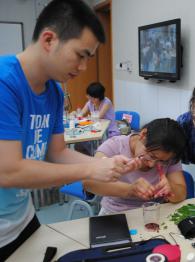
About the Project
This project is one of the 2012 WISE Awards finalists.
Developed at Northwestern University and propelled by an initial grant from the National Science Foundation in 1994, the Materials World Modules (MWM) Program was established to undertake the development and dissemination of supplemental materials science education curricula for middle and high school students.
Given the pervasiveness of materials in everyday life, the developers of MWM felt that the study of materials would facilitate students’ discovery of the interconnections between science, technology, and society (STS). Thus, the curriculum was constructed around the theme of materials science and engineering.
The aim of the MWM program is to use cross-cutting concepts and hands-on activities to deepen student understanding of STEM and boost student achievement. MWM has been found through studies to have a widespread, positive impact in a variety of classroom settings, whether urban or rural, rich or poor. In fact, teachers in all subject areas reported that the use of the modules enabled students to make connections between concepts from the traditional curriculum and the world around them more frequently than ever before.
Context and Issue
High schools have historically taught mathematics, chemistry, physics, biology, and technology as discrete subjects. This compartmentalization of knowledge leads students to understand these fields as sets of decontextualized techniques and facts rather than integrated disciplines that complement each other and that are frequently used as instruments to solve real problems. The MWM educational program employs materials science as a context in which students can study various STEM subjects in relation to one another and learn how to apply them directly to real problems and societal issues.
US rankings in math and science achievements among high school students continue to fall. Trends in the International Mathematics and Science Study (TIMMS) indicate a drastic decline in the US from 9th place to 27th place in science and 15th place to 28th place in math. Even more, between 1986 and 2000, the annual growth in first university degrees in science and engineering increased by more than 75 percent in East Asia, and less than 19 percent in the US. Such findings make it obvious that there is an urgent need for a new approach to learning in the STEM areas in the US, and MWM hopes to eventually spread the success of this innovative approach to other countries as well.
The innovative way MWM approaches learning truly creates success in classrooms. One teacher said, “No matter how many times I explain, students always respond with, ‘I don’t get it’. After these activities, everybody had some knowledge they wanted to share. I would say again how much difference there is in ‘teaching’ and ‘allowing the students to learn.’ I was amazed at the way all of the students, even the ones I had little hope for, got involved and retained what they studied. It was the retention that was perhaps most impressive. I can often engage them by entertaining, but in this instance, they entertained themselves and actually remembered the material.”
Solution and Impact
The underlying principle behind MWM is that by studying materials in a manner that facilitates greater awareness of the relationships between scientific and technological concepts and real-world applications, students will be able to confront real problems and societal issues.
The MWM program is relevant because the modules bring the latest research topics to the classroom and emphasize the historical development of products and technologies through human efforts. Students are provided with a broader perspective on scientific topics as they develop their research skills. Approaching science and technology with a social context helps students see how science is relevant to their lives, empowering them to make better decisions as citizens of the world. The modules employ a team approach, giving students opportunities to collaborate on design projects. Finally, MWM is in alignment with the Next Generation Science Standards (NGSS).
The beneficiaries of MWM are middle and high school students in the US, Mexico, and Qatar. The developers of MWM intend to expand the reach of the program to include an increasing population of students around the world. To date, over 100,000 students have been reached, and the project has been replicated in Singapore, Pakistan, and China.
Future Developments
MWM seeks to enhance its proven inquiry and design methodology with multimedia tools to better prepare students for 21st-century STEM careers. Called I-MWM, this innovative program will integrate multimedia learning experiences into the module program. The benefits of this new platform include rapid feedback assessments, independent and self-directed learning, and elimination of redundancy and misconceptions.
The I-MWM program will be available on mobile devices and will utilize multiple teaching and collaborating pathways, such as interactive games, simulations, animations, and videos. By tapping into multiple learning modalities, students can hear and watch multimedia content, allowing them to conceptualize and visualize the nanoscale in their classrooms without using expensive equipment. These tools can convey complex concepts like 3D spatial and time-dependent phenomena much better than static textbooks.